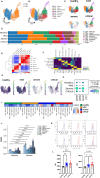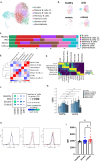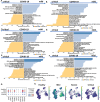CD55 upregulation in T cells of COVID-19 patients suppresses type-I interferon responses
- PMID: 40316776
- PMCID: PMC12048498
- DOI: 10.1038/s42003-025-08066-z
CD55 upregulation in T cells of COVID-19 patients suppresses type-I interferon responses
Abstract
Complement overactivation, has been verified in COVID-19 patients. Complement regulatory proteins, including CD55, control complement overactivation thus eliminating complement deposition and cell lysis. We investigated complement regulatory protein expression in COVID-19 for potential deregulated expression patterns driving disease pathogenesis. Single-cell RNA-seq revealed increased PBMCs CD55 expression in severely and critically ill patients. This increase was also detected upon integrated subclustering analysis of monocyte, T cell and B cell populations. FACS analysis confirmed the significant upregulation of CD55 expression in CD4+ and CD8+ T cells and monocyte populations of severely and critically ill COVID-19 patients. This upregulation was associated with decreased expression of type-I IFN-stimulated genes (ISGs) in patients with severe and critical COVID-19, indicating a suppressor effect of CD55. Silencing of CD55 in T cells from COVID-19 severely ill patients in vitro and sensitization with SARS-CoV-2 peptides resulted in significantly augmented expression of ISGs and a reversal of their expression to levels similar to control or higher. The present study uncovers, to the best of our knowledge, a novel regulatory effect of CD55 on type-I IFN responses of severely ill COVID-19 patients, thus indicating its contribution to COVID-19 pathogenesis, and identifies a novel mechanistic pathway in the COVID-19 immune response.
© 2025. The Author(s).
Conflict of interest statement
Competing interests: All authors declare no competing interests.
Figures







References
MeSH terms
Substances
LinkOut - more resources
Full Text Sources
Medical
Research Materials
Miscellaneous

